With travellers seeking out more authentic, immersive experiences, it seems that more and more are opting to take only photos and memories back home with them. Perhaps it’s due to dwindling baggage allowances, but there are still some souvenirs worth holding the space for: those that speak of hours of crafting and care, those keeping local artisans in business, those that are true, built-for-life heirloom pieces. Some even — rather than being made en masse — crafted by your very own hands.
In the interests of buying mementoes with the environment and the benefit of local communities in mind, here’s our sustainable shopping guide to souvenirs with staying power (and the hotels who were hip to these covetable keepsakes first).
For timeless tableware
SYTCH FARM STUDIOS, UK
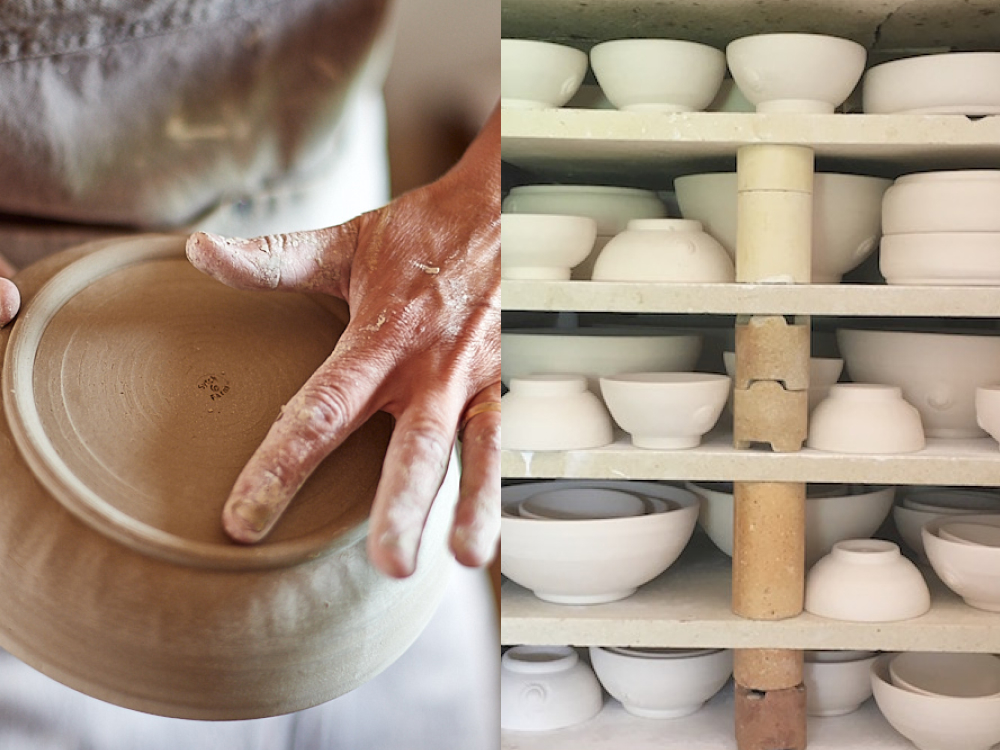
Dine at Hampton Manor’s Grace & Savour restaurant, and once you’ve polished off chef David Taylor’s delicious Scandi-leaning fare, be sure to take a closer look at your plate — you might notice a delicate ammonite imprinted into the ceramic. Not just part of a pattern, this is a totem of ancient Cornish craftsmanship, the work of potter Gill Thompson of Sytch Farm Studios, whose stoneware has found a natural home here where the land — and surrounding kitchen gardens — inform the menu.
These pieces have become star-chef favourites: Tom Kerridge was the first to become a fan, commissioning a set of dishes made to the exact specifications of a new dessert he’d conceived, at CarFest of all places… So, with glowing recommendations in place, start your collection of wares that turn your table covetable.
Where to get it At Sytch Farm Studios in Shrewsbury.
What to buy Serving bowls bearing rockpool-esque glazing, or sunset-hued starbursts; gold-speckled heart-shaped dishes; and condiment sets. Or delightfully wonky, wabi-sabi chopping boards and a range of rustic knives (from filleters to cleavers) made by Gill’s carpenter partner Jon.
Why you’ll want it Because these are an ode to traditional Cornish makers — Gill sources her clay from a pit in St Agnes, run by a small farm owner, the same clay she used to play with at primary school — and they’re designed to foster a sense of connection to the maker and an appreciation of the materials. The ammonite marking is an homage to Gill’s roots and to how clay is formed; she also adds a thumbprint as a personal touch, plus some happy imperfections (not-quite circular bowls, crackling colour), to add more character. Former kitchen-builder Jon switched to greener, smaller-scale production, instead making knives and chopping boards, but he sometimes takes custom orders for ‘river tables’, cut through with an all-natural resin made using broad beans.
To join the furoshiki fold
MUSUBI KYOTO, JAPAN
Frankly, we want everything in the Kengo Kuma-designed, Kyoto outpost of the cool-as-can-be Ace hotel group: the bold graphic prints by legendary artist Samirō Yunoki, neon artwork by Hysteric Glamour founder Nobuhiko Kitamura, reissued George Nakashima rugs, kimonos by Wings + Horns… Honestly, it would be easier if we just moved in.
The Ace does have a boutique, but it sells a small fraction of what you’ll want on-site. Fret not, though, because if you’re taken with the funky fabric on your room’s futon cushions, the designers behind textile brand Minä Perhonen have also shared their mod stylings with sustainably-minded, furoshiki-cloth makers Musubi, so you can make your home look Ace too.
Where to get it The Musubi store in Kyoto is less than a 10-minute walk from the hotel in the Torayacho neighbourhood. They also have a store in Tokyo’s Jingūmae district.
What to buy A furoshiki cloth — a Japanese craft form so simple and effective it’s been used for centuries. These versatile cloths are best known as a stylishly sustainable way to wrap gifts; but those with more origami nous might also know them as bags and cushion covers. Musubi has the more classic rayon style, scattered with sakura print, but we love the modern Japandi styles by Minä Perhonen and Masaru Suzuki.
Why you’ll want it Furoshiki wrappings have been used in Japan for more than 1,300 years, whether for protecting valuables at home or your clothes while using a steam bath. There’s a sensitivity inherent in the craft, whose name comes from kanji representing a pregnant woman admiring her belly, or growing a fruit from nothing. Wrapping a gift daintily in furoshiki adds an extra layer of care, quite literally.
This ethos is embedded in Musubi’s work practices too: they use sustainable organic cotton and recycled polyester, sell a range of regional products in their stores to help small local businesses, and support artists with disabilities; and the cloth itself is a gift that keeps giving, which can turn from bag to scarf to homeware. There are styles to suit all (although you can go custom too), plus wooden bag clips and handles to add structure, and plenty of how-to videos on their website.
For heritage Balearic glassware
GORDIOLA, MALLORCA
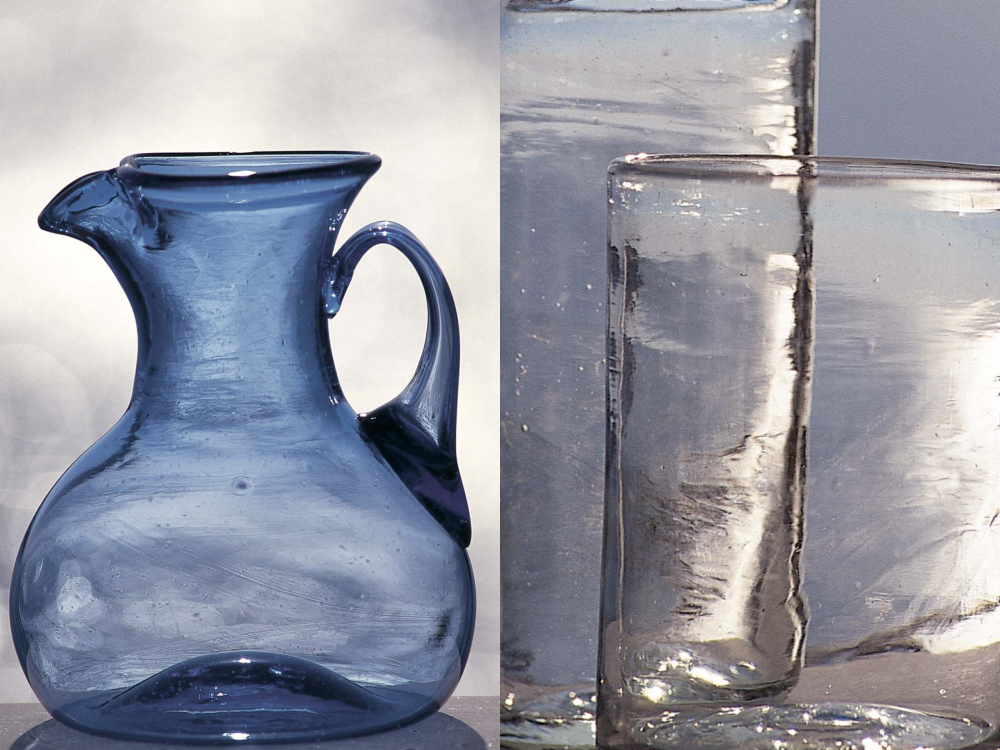
Bijou Mallorcan hotel Portella doesn’t just have one of the city’s most wanted locations, practically next door to the Cathedral in the Old Town. It also has impeccable taste in decor, and uses its sense of style to showcase one of the island’s revered, antique institutions: Gordiola glassmakers, a family outfit whose all-fired-up fans include royalty and celebrities.
Stay here and you can pretend you have a home bedecked with custom-made pieces, from the light fixtures to the saffron-hued glassware in suite kitchens. Or, even better, stock up in their Palma store or their glass-blowing workshop outside the city.
Where to get it Cast your magpie’s eye to 2 Carrer de la Victòria, a five-minute walk away from Portella in Palma, or make the 30-minute drive to Algaida to see artisans in action.
What to buy Even Gordiola’s simplest product, the Hydria glass, is a beauty. It’s sturdy, its subtle ripples and left-on-purpose bubbles make it look like the sun-dappled Med, and it comes in colours from amethyst to topaz to green. Those looking for a little more flair can buy slender oil mills and candlesticks shaped like palm trees or commission a full-on chandelier.
Why you’ll want it Gordiola has been at the forefront of Balearic glass-blowing for three centuries and counting; they’re the oldest brand in the islands (which has stayed in the Gordiola clan for 11 generations), and the fourth oldest in Spain; and they’ve helped to make glass-blowing an Intangible Cultural Heritage of Spain. All impressive accomplishments, but you’ll be even more bowled over by the artistry.
Impossibly delicate lighting, with botanical curlicues and tendrils and sinuous Arabian-style teapots show the kind of confident craftsmanship accrued via a long history of fine-tuning. Here you can learn more about the art — plus the adventurous life of 10th-gen patriarch Daniel Aldeguer Gordiola, who was once allegedly mistakenly kidnapped as a suspected CIA activist — and find a one-of-a-kind treasure.
For masks and myths
GALLE FORT ART GALLERY, SRI LANKA
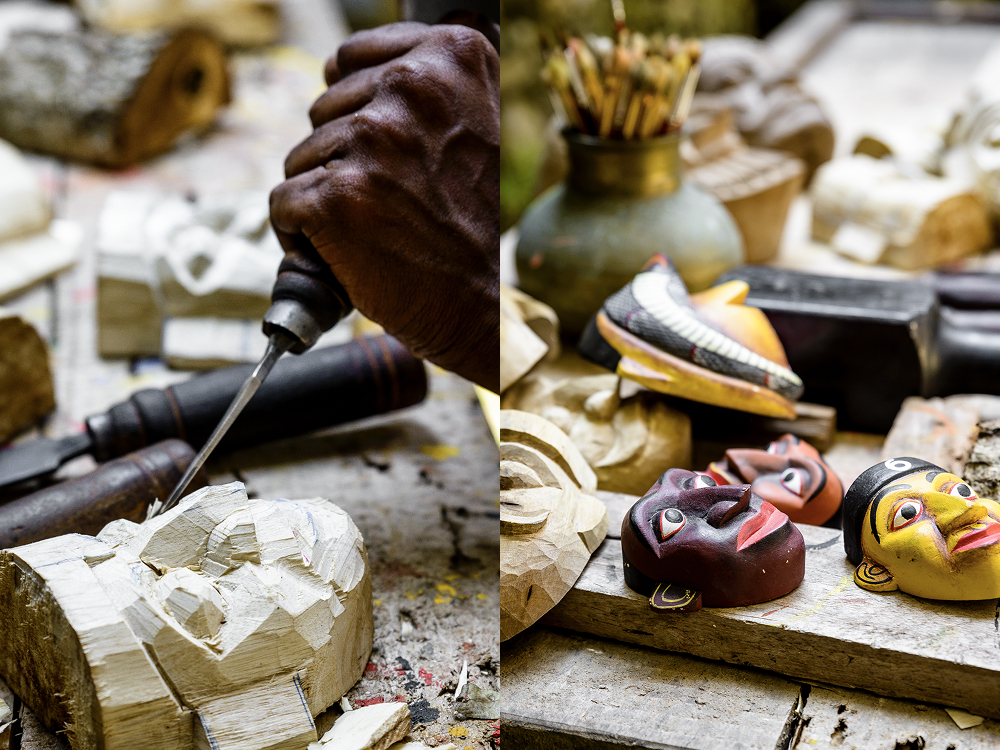
The Aman group always considers how best to offer guests a meaningful connection to the destination they’re staying in. For example, kite-making at the Aman Summer Palace in Beijing, private Buddhist teachings at Amantaka in Laos or rustic pottery lessons at Turkey’s Amanruya. Sri Lanka’s Amangalla offers an experience that promises cultural immersion, hands-on crafting and a meaningful souvenir all in one, at a mask-making workshop in nearby Galle.
Where to get it The hotel has partnered with esteemed Galle Fort Art Gallery, set inside the walls of its namesake landmark, close to Galle Fort Beach.
What to buy During this experience, you’ll make a wooden mask in the traditional style of a deity, ancestral figure or mythical creature. For example, you might bring to life a Raksha devil mask with bulging eyes and protruding tongues, intended to ward off evil; one of 18 types of Sanni mask (traditionally worn by a Sri Lankan artist-exorcist), each said to cure a certain type of illness; or a Kolam mask, depicting characters derived from Buddhist folk theatre.
Why you’ll want it The tradition of Sri Lankan mask carving and the ‘devil dancing’ they sometimes play a part in was influenced by the craftsmanship and ritual in Malabar and Kerala in India. The pendant-shaped island has made the art its own, infusing their lore and beliefs into these brightly painted and effectively exaggerated visages.
They might banish a demon, bring blessings, protect you, pit good and evil against one another through dance, or simply accentuate your wall in fierce fashion. The local artisans at Galle Fort Gallery have taken the original designs and refined them, pre-carving them with soft kaduru wood, so you can run riot over them with a paintbrush.
For the cosiest and coolest blankets
PENDLETON WOOL MILL, OREGON
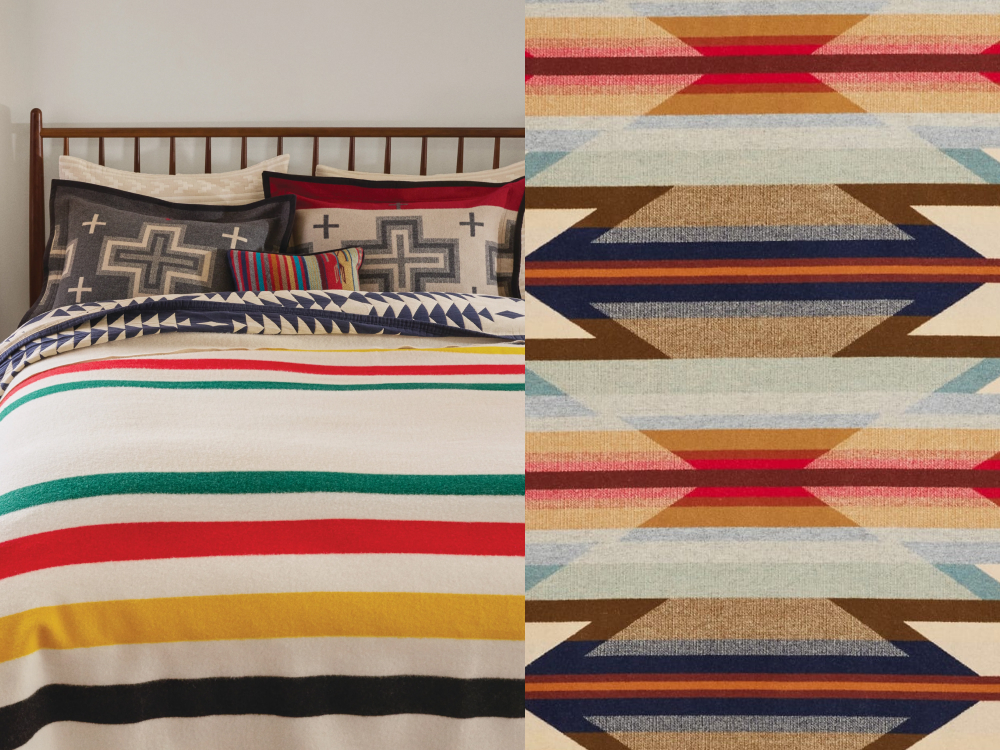
You may already know the cosseting touch of a Pendleton blanket, perhaps without even realising, as many hotels rocking a hip folksy look have draped them over their beds: the Ace Hotel Kyoto (again), Catskills camp Eastwind Oliverea Valley, several of The Standard hotels… But if you want to buy one at the source and make the pilgrimage (mill-grimage?) to Oregon for a tour of their factory, you can swaddle yourself in style at Sentinel in Portland.
Where to get it There are two mills you can tour, in Pendleton and Washougal — the latter is easiest to reach from Sentinel, just a half-hour drive away.
What to buy Pendleton don’t just make blankets — at their Portland mills, they craft anything you might want to snuggle into: towels, throws, robes, coverlets, hoodies, coats… Even your dog can have a Pendleton bed. But nestle up in one of these dreamily soft, virgin-wool babies, with designs inspired by America’s great outdoors, and you’ll have the most stylish snooze of your life.
Why you’ll want it Thanks to Pendleton’s design team, you can take an abstract road trip through the States — Montana’s Mystic Lake; Grand Teton National Park, Wyoming; Utah’s Sunset Pass — without getting out of bed. Pendleton’s bold colours and jazzy patterns recall Native and folk-art tropes, with hues lifted from landscapes — the company may have been started by English weaver Thomas Kay in the 19th century (the sixth generation of the Kay family still own it), but it has worked with indigenous artists and donates a portion of its proceeds to the American Indian College Fund.
The blankets were a prized item back in the Old West, loved for their warmth, durability and bright colours, and they’ve become an icon of Americana, with older, rarer blankets selling for thousands of dollars secondhand. The company’s since built out the brand to include men’s and womenswear, and a beach collection, but customers keep clamouring for comfort — and if you’re similarly enamoured, you can pick up something snug after the tour.
For unshakeable umbrellas
ALOIS KIRCHTAG, AUSTRIA
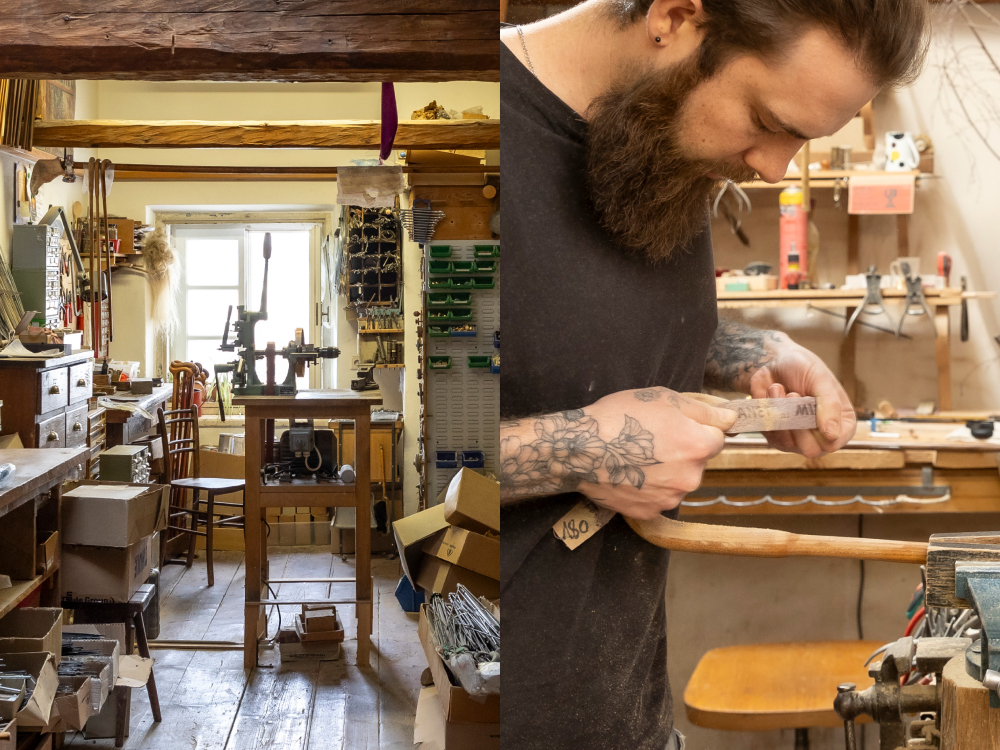
Among the well-heeled guests at lakeside Austrian hideaway Rosewood Schloss Fuschl, you’ll notice some striding pridefully with a very special kind of umbrella. We know, we know, they’re not the sexiest of souvenirs, but for something functional, this is the finest in form you can get.
The family-owned Alois Kirchtag workshop — in a 15th-century house with crumbly stone walls — is where the art of umbrella-making has been honed over centuries; today it stays true to its roots, using high-end materials and traditional methods. It isn’t usually open to the public, but the hotel can arrange a private tour and introduce you to the current Kirchtag patriarch, making it the ultimate rainy-day activity.
Where to get it The workshop has moved around Salzburg a few times, but currently resides along the city’s famous shopping street, Getreidegasse.
What to buy An umbrella, but not just any umbrella; the Kirchtag family’s products are the result of craftsmanship handed down through generations. The limited-edition Porsche design is one of their top models, but if you’re unable to get your hands on one, your dream brolly can be custom-made in store.
Why you’ll want it For the Kirchtags, open umbrellas indoors are probably lucky — how better can they show off their intricate stitching, sophisticated colourways, brass and horn detailing, and lovingly tooled handles, each made from a unique piece of blackthorn, cherry, oak, walnut or ash (500 kilos worth of trunks are used here a year). In the 1980s, the Kirchtags paused umbrella production, but frame-maker Tobias Ott campaigned to bring back the craft, and now 400 per year are produced on-site. Their price tags rise into the hundreds, but — as staff put it — this means you’ll be less likely to forget it somewhere.
It seems reasonable considering the work involved: handles are steeped in linseed oil and dried for months, before being sanded by hand. Springs are made from piano wire, the canopy is hand cut and sewn by an in-house seamstress, and the ribbon used to close the umbrella is finished with a mother-of-pearl button. All materials are natural, down to the fish-oil glue and horn ferrule; and customers get free repairs for life.
For more shopping inspiration, see our fly-and-buy guides to New York and East London



